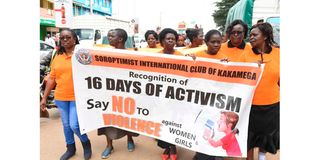The three sisters that birthed 16 Days of Activism

A group of women march on the streets of Kakamega town to mark the 16 days of activism Against Gender-Based Violence in 2019. This day was ushered in by the happenings on November 25, 1960, in the Dominican Republic.
What you need to know:
- Former President Rafael Trujillo, who historians describe as a brutal dictator and who ruled for three decades, is reported to have had his secret police club three to death, before dumping them down a cliff.
- The trio were political activists who fiercely protested his ruthless leadership.
The happenings on November 25, 1960, in the Dominican Republic ushered in a new era of women rights advocacy.
Former President Rafael Trujillo, who historians describe as a brutal dictator and who ruled for three decades, is reported to have had his secret police club three sisters Patria, Minerva and Maria Teresa Mirabal to death, before dumping them down the cliff.
The trio were political activists who fiercely protested his ruthless leadership. Their death, however, marked the beginning of transformational feminism, the kind that challenges status quo to create a just society.
For their murder, November 25 became a special day for the whole world.
From 1981, the Latin America and the Caribbean commemorated it as “a day against violence against women,” after the inaugural Feminist Encuentro (gathering) declared it so.
Global campaign
Then in June 1991, the Centre for Women’s Global Leadership alongside feminists who had attended the first Women’s Global Institute on Women, Violence and Human Rights, called for a global campaign of 16 days of activism against gender-based violence (GBV).
The campaign period, starting on November 25 and ending on December 10, the International Human Rights Day.
Since then, the world has spent these days to raise awareness on the impact of GBV, reflect on the progress made and the challenges, and forge new partnerships.
With a growing global recognition on the need to end violence against women, on December 20, 1993, the United Nations General Assembly adopted the Declaration on the Elimination of Violence against Women through resolution 48/104. This opened the door for collaborations in the fight against GBV.
Civil society
Later on February 7, 2000, the assembly officially designated November 25, as International day for the Elimination of Violence against Women. This day thereby, galvanises to action governments, international organisations, civil society and feminists.
The UN has since branded it the Orange Day, the colour representing “a future free from violence against women and girls.”
The activities during this period further draw significance from the former UN Secretary-General’s Ban Ki-moon support for global action against GBV.
In 2008, he launched the United Nations Secretary-General’s UNiTE by 2030 to End Violence against Women campaign, a multi-year effort purposed to prevent and eliminate violence against women and girls around the world.




